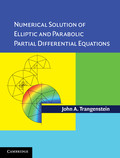Book contents
- Frontmatter
- Contents
- Preface
- 1 Introduction to Partial Differential Equations
- 2 Parabolic Equations
- 3 Iterative Linear Algebra
- 4 Introduction to Finite Element Methods
- 5 Finite Element Theory
- 6 Finite Element Approximations
- 7 Mixed and Hybrid Finite Elements
- 8 Finite Elements for Parabolic Equations
- 9 Finite Elements and Multigrid
- 10 Local Refinement
- Nomenclature
- References
- Author index
- Subject index
4 - Introduction to Finite Element Methods
Published online by Cambridge University Press: 05 May 2013
- Frontmatter
- Contents
- Preface
- 1 Introduction to Partial Differential Equations
- 2 Parabolic Equations
- 3 Iterative Linear Algebra
- 4 Introduction to Finite Element Methods
- 5 Finite Element Theory
- 6 Finite Element Approximations
- 7 Mixed and Hybrid Finite Elements
- 8 Finite Elements for Parabolic Equations
- 9 Finite Elements and Multigrid
- 10 Local Refinement
- Nomenclature
- References
- Author index
- Subject index
Summary
In Chapter 2 we developed finite difference approximations to parabolic partial differential equations.We restricted our development to first- and second-order discretizations, because higher-order finite difference approximations are difficult to develop and to analyze. In this chapter, we will adopt a different approach to discretization of partial differential equations. Instead of approximating derivatives by difference quotients, we will approximate the solution of the equation by piecewise polynomials and require that the piecewise polynomial approximations satisfy weak forms of the partial differential equations. This approach will have advantages that finite differences cannot offer. For example, we will be able to develop approximations to differential equations with Dirac delta-function forcing. Also, in multiple dimensions we will develop natural ways to deal with curved boundaries.
The finite element approach will require a number of mathematical developments. Our goal in this chapter is to introduce the fundamental principles of finite element computations. These principles include development of the differential equation in weak form, developing shapes used in tessellations of computational domains, assembling polynomial families, choosing quadrature rules, generating meshes and assembling linear systems. The following Chapter 5 will develop the theory needed for the analysis of finite element methods, and the subsequent Chapter 6 will review the details of finite element implementations by means of that theory. Chapter 7 will discuss some alternative finite element implementations.
- Type
- Chapter
- Information
- Publisher: Cambridge University PressPrint publication year: 2013

